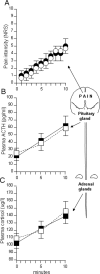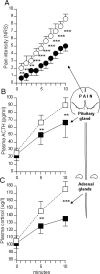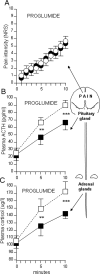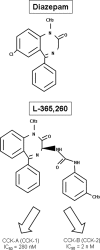The biochemical and neuroendocrine bases of the hyperalgesic nocebo effect
- PMID: 17108175
- PMCID: PMC6674855
- DOI: 10.1523/JNEUROSCI.2947-06.2006
The biochemical and neuroendocrine bases of the hyperalgesic nocebo effect
Abstract
Despite the increasing research on placebos in recent times, little is known about the nocebo effect, a phenomenon that is opposite to the placebo effect and whereby expectations of symptom worsening play a crucial role. By studying experimental ischemic arm pain in healthy volunteers and by using a neuropharmacological approach, we found that verbally induced nocebo hyperalgesia was associated to hyperactivity of the hypothalamic-pituitary-adrenal (HPA) axis, as assessed by means of adrenocorticotropic hormone and cortisol plasma concentrations. Both nocebo hyperalgesia and HPA hyperactivity were antagonized by the benzodiazepine diazepam, suggesting that anxiety played a major role in these effects. The administration of the mixed cholecystokinin (CCK) type-A/B receptor antagonist proglumide blocked nocebo hyperalgesia completely but had no effect on HPA hyperactivity, which suggests a specific involvement of CCK in the hyperalgesic but not in the anxiety component of the nocebo effect. Importantly, both diazepam and proglumide did not show analgesic properties on basal pain, because they acted only on the nocebo-induced pain increase. These data indicate a close relationship between anxiety and nocebo hyperalgesia, in which the CCKergic systems play a key role in anxiety-induced hyperalgesia. These results, together with previous findings showing that placebo analgesia is mediated by endogenous opioids, suggest that the analgesic placebo/hyperalgesic nocebo phenomenon may involve the opposite activation of endogenous opioidergic and CCKergic systems.
Figures







References
-
- Baber NS, Dourish CT, Hill DR. The role of CCK, caerulein, and CCK antagonists in nociception. Pain. 1989;39:307–328. - PubMed
-
- Beinfeld MC. Cholecystokinin in the central nervous system: a minireview. Neuropeptides. 1983;3:411–427. - PubMed
-
- Benedetti F. The opposite effects of the opiate antagonist naloxone and the cholecystokinin antagonist proglumide on placebo analgesia. Pain. 1996;64:535–543. - PubMed
Publication types
MeSH terms
Substances
LinkOut - more resources
Full Text Sources
Other Literature Sources
Medical
